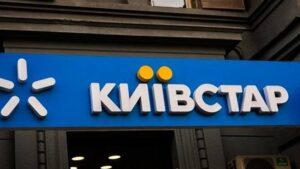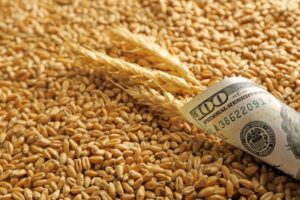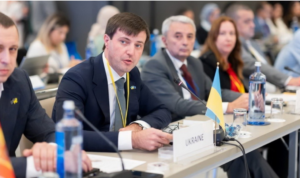
Kyivstar, Ukraine’s largest telecommunications operator, may acquire Sanvin 11 LLC (Odesa), which owns a 12.95 MW solar power plant in Zhytomyr region that was commissioned in 2019.
According to the Antimonopoly Committee of Ukraine on its website, the issue of granting the relevant permission will be considered on Thursday.
According to YouControl, Sanvin 11 is currently owned on a parity basis by Czech citizen Natalia Bogachova and Israeli citizen Peter Rosenkrantz through the Cypriot company Merestono Limited.
Last year, the company increased its revenue by 16% to UAH 89.0 million, while its net profit grew by 62.9% to UAH 33.2 million.
Kyivstar serves nearly 23 million mobile subscribers and over 1.1 million home internet subscribers. Recently, the company, which accumulated a significant amount of free cash during the war amid currency restrictions, has been actively investing in other industries and expects to reap synergies from these investments.
Its portfolio of digital services includes the Helsi medical platform, the Kyivstar TV film and television platform, and Uklon, a leading ride-hailing and delivery company. Kyivstar is also a provider of solutions for corporate clients, offering cloud technology, cyber security, and artificial intelligence services. Through its Kyivstar.Tech division, the company is developing software development in Ukraine and is a partner for international technology companies such as Starlink.
In the second quarter of this year, Kyivstar increased its net profit by 18.6% compared to the same period in 2024, to UAH 3.4 billion, while its operating revenue grew by 25.9%, to UAH 11.86 billion.

Novokramatorsk Machine-Building Plant (NKMZ, Kramatorsk, Donetsk region) ended January-September of this year with a loss of UAH 108.9 million, while for the same period last year, net profit amounted to UAH 73.7 million.
According to the financial report published on the plant’s website, net income increased by 51% to UAH 1 billion 174 million.
NKMZ received UAH 268 million in gross profit, up 6%, with UAH 92.6 million in operating losses (UAH 2.4 million for the same period last year).
Products worth UAH 919.6 million were exported, accounting for 78.3% of total revenue (82% a year earlier).
India was the largest importer of products, with deliveries increasing by 15.5% to UAH 423.8 million. Exports to Lithuania increased by 57.5% to UAH 137.8 million, to Poland by 3.6 times to UAH 12.4 million, and to
Kazakhstan amounted to UAH 17 million compared to UAH 1.1 million last year.
Products were also supplied to countries to which there were no deliveries in January-September 2024, in particular, to Bulgaria – worth UAH 84.3 million, and China – worth UAH 48 million.
Deliveries to Ukrainian customers increased by 86.4% to UAH 254.7 million.
As reported, the plant ended the first half of this year with a loss of UAH 61.2 million, which is seven times more than in the same period last year, with net income more than doubling to UAH 795.5 million.
Thus, in the third quarter of this year, NKMZ incurred a loss of UAH 47.7 million, while in the same period of 2024, net profit amounted to UAH 82.2 million. Net income decreased by 5% to UAH 378.7 million.
“The company’s activities in the fourth quarter of 2025 and in 2026 will most likely be limited,” the report states.
NKMZ reminds that the company is located in the frontline territory, and the most important factor remains its activities “in the context of the Russian Federation’s military aggression against Ukraine.” This has led to a significant reduction in production volumes and has resulted in the irregular nature of production and economic activities. In particular, in October-December of this year, it is expected to manufacture and sell commercial products worth UAH 327 million, 5,000 tons of liquid steel (4,800 tons were produced in the third quarter), 300 tons of steel castings (284 tons), 3,600 tons of forgings (3,570 tons), and 5,700 model sets and packages (5,370) are expected to be produced and sold.
“The draft production plans for 2026 include 12,000 tons of machinery and equipment for the metallurgical, mining, and construction industries, lifting and loading and unloading equipment, and spare parts,” the report says.
According to the report, the value of contracts concluded but not yet fulfilled as of September 30, 2025, amounted to UAH 672.95 million. The expected profits from their fulfillment are UAH 171.87 million.
NKMZ is a city-forming enterprise in Kramatorsk, the largest in Ukraine in the production of rolling, metallurgical, forging and pressing, hydraulic, mining, lifting and transport, hydraulic and railway equipment.
As reported, NKMZ’s capacities were forced to be mothballed with the start of the full-scale military invasion of Ukraine by the Russian Federation, and on October 1, 2023, it began to partially resume operations.
The plant ended last year with a net profit of UAH 36.3 million, while in 2023, the loss amounted to UAH 856.93 million, and net income increased 3.2 times to UAH 1.15 billion, in particular, products worth UAH 941.3 million (82%) were exported.
For the current year, the plant has preliminarily planned to increase sales by 81.5% compared to 2024, to UAH 2.08 billion.
The number of employees at the beginning of 2025 was 5,660.

In January-October of this year, the Zaporizhstal Iron and Steel Works in Zaporizhia increased rolled steel production by 14.5% compared to the same period last year, to 2 million 291.8 thousand tons.
According to the plant’s press release, steel production for the period amounted to 2 million 660.6 thousand tons (in January-October 2024 – 2.418 million tons), and pig iron production amounted to 2 million 945.1 thousand tons (2.5622 million tons).
In October, Zaporizhstal produced 302,500 tons of pig iron, 275,400 tons of steel, and 204,900 tons of rolled products, while in the previous month it produced 303,400 tons of pig iron, 279,800 tons of steel, and 247,300 tons of rolled products.
As reported, in 2024, Zaporizhstal increased its rolled steel output by 18.1% compared to 2023, to 2 million 426.7 thousand tons from 2 million 54.7 thousand tons, and steel output by 17.2%, to 2 million 890.8 thousand tons, and pig iron by 14.2%, to 3 million 106.3 thousand tons.
In 2023, Zaporizhstal increased its rolled steel production by 57.2% compared to 2022, to 2 million 54.7 thousand tons, steel by 65.4%, to 2 million 466.9 thousand tons, and pig iron by 35.3%, to 2 million 718.9 thousand tons.
Zaporizhstal is one of Ukraine’s largest industrial enterprises, whose products are in high demand among consumers both in the domestic market and in many countries around the world.
Zaporizhstal is a joint venture of the Metinvest Group, whose main shareholders are System Capital Management (71.24%) and Smart Steel Limited (23.76%). Metinvest Holding LLC is the managing company of the Metinvest Group.

According to Serbian Economist, Ukrainian President Volodymyr Zelensky held a telephone conversation with Serbian President Aleksandar Vucic, during which the parties discussed European integration in detail and agreed to stay in touch. Zelensky reported on the conversation on his Telegram channel. The leaders also touched on coordination on regional security and the immediate international agenda.
We remind you that the day before, the European Commission published its annual reports on EU enlargement. The document on Serbia notes both the advanced elements of reforms and sensitive issues of foreign policy alignment with the EU. Vučić publicly reiterated his position that membership should be assessed on the basis of merit criteria rather than political alignment, against the backdrop of discussions on sanctions policy and dialogue on Kosovo.
At the same time, Kyiv is seeking to accelerate its own negotiation track with the EU. On the day the enlargement package was published, Zelensky called for the process to be brought to the opening of all clusters and for accession to be targeted by 2030, recognizing the need for further anti-corruption and institutional reforms.
In the context of the European Commission’s report, Belgrade is set to engage in dialogue with Brussels on aligning its foreign policy and economic agreements, while Kyiv is focusing on implementing recommendations for the next stage of negotiations. The positions of the leaders following the conversation indicate a willingness to maintain working contacts and exchange experiences in sectors related to the European agenda.
The previous confirmed call between Zelensky and Vučić took place on May 22, 2025.
https://t.me/relocationrs/1685

Ukraine exported 3.2 million tons of grains and oilseeds in the first four months of the 2025-2026 marketing year (MY, July-June), according to the Ukrainian Grain Association on Facebook.
According to the infographic, exports were most active in August (3.3 million tons) and October (3.21 million tons). At the same time, exports in October exceeded September figures (2.4 million tons) by 32%.
Wheat sales peaked in August at 2.048 million tons, which is 36.5% more than in October (1.5 million tons). Barley exports were also most active in August (324,000 tons), which is 36.1% more than in September (238,000 tons) and 62% more than in October (200,000 tons).
Corn exports, on the other hand, picked up in October and reached 1.094 million tons, significantly more than the September figure of 61 thousand tons and the August figure of 230 thousand tons.
Foreign trade in soybeans also picked up in October – 230 thousand tons, compared to 78 thousand tons in September and 208 thousand tons in August this year.
Rapeseed exports were most active in August – 519 thousand tons, while in September and October, 220 thousand tons and 177 thousand tons were delivered to foreign markets, respectively.

Ukraine is participating for the first time in the 48th session of the General Fisheries Commission for the Mediterranean (GFCM) in Malaga on November 3-9, 2025, as a full member. The updated list on the FAO website states that Ukraine became a contracting party on September 11, 2025.
The Commission consists of 24 contracting parties: Albania, Algeria, Bulgaria, Croatia, Cyprus, Egypt, the European Union, France, Greece, Israel, Italy, Lebanon, Libya, Malta, Monaco, Montenegro, Morocco, Romania, Slovenia, Spain, Syria, Tunisia, Turkey, and Ukraine. Five cooperating non-contracting parties are also involved in the work: Bosnia and Herzegovina, Georgia, Jordan, Moldova, and Saudi Arabia.
The official program of the session will take place from November 3 to 9, 2025. The decisions will be published by the FAO after the session closes. FAOHome